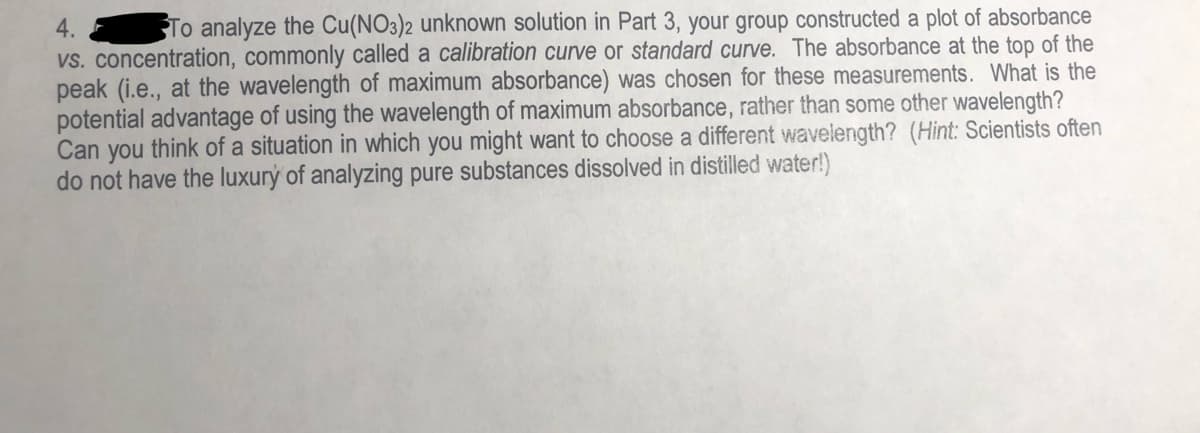4. To analyze the Cu(NO3)2 unknown solution in Part 3, your group constructed a plot of absorbance vs. concentration, commonly called a calibration curve or standard curve. The absorbance at the top of the peak (i.e., at the wavelength of maximum absorbance) was chosen for these measurements. What is the potential advantage of using the wavelength of maximum absorbance, rather than some other wavelength? Can you think of a situation in which you might want to choose a different wavelength? (Hint: Scientists often do not have the luxurý of analyzing pure substances dissolved in distilled water!)
4. To analyze the Cu(NO3)2 unknown solution in Part 3, your group constructed a plot of absorbance vs. concentration, commonly called a calibration curve or standard curve. The absorbance at the top of the peak (i.e., at the wavelength of maximum absorbance) was chosen for these measurements. What is the potential advantage of using the wavelength of maximum absorbance, rather than some other wavelength? Can you think of a situation in which you might want to choose a different wavelength? (Hint: Scientists often do not have the luxurý of analyzing pure substances dissolved in distilled water!)
Chemistry & Chemical Reactivity
9th Edition
ISBN:9781133949640
Author:John C. Kotz, Paul M. Treichel, John Townsend, David Treichel
Publisher:John C. Kotz, Paul M. Treichel, John Townsend, David Treichel
Chapter4: Stoichiometry: Quantitative Information About Chemical Reactions
Section4.8: Stoichiometry Of Reactions In Aqueous Solution-titrations
Problem 2RC
Related questions
Question

Transcribed Image Text:4.
To analyze the Cu(NO3)2 unknown solution in Part 3, your group constructed a plot of absorbance
vs. concentration, commonly called a calibration curve or standard curve. The absorbance at the top of the
peak (i.e., at the wavelength of maximum absorbance) was chosen for these measurements. What is the
potential advantage of using the wavelength of maximum absorbance, rather than some other wavelength?
Can you think of a situation in which you might want to choose a different wavelength? (Hint: Scientists often
do not have the luxurý of analyzing pure substances dissolved in distilled water!)
Expert Solution
This question has been solved!
Explore an expertly crafted, step-by-step solution for a thorough understanding of key concepts.
This is a popular solution!
Trending now
This is a popular solution!
Step by step
Solved in 2 steps

Recommended textbooks for you

Chemistry & Chemical Reactivity
Chemistry
ISBN:
9781133949640
Author:
John C. Kotz, Paul M. Treichel, John Townsend, David Treichel
Publisher:
Cengage Learning

Macroscale and Microscale Organic Experiments
Chemistry
ISBN:
9781305577190
Author:
Kenneth L. Williamson, Katherine M. Masters
Publisher:
Brooks Cole

Chemistry & Chemical Reactivity
Chemistry
ISBN:
9781133949640
Author:
John C. Kotz, Paul M. Treichel, John Townsend, David Treichel
Publisher:
Cengage Learning

Macroscale and Microscale Organic Experiments
Chemistry
ISBN:
9781305577190
Author:
Kenneth L. Williamson, Katherine M. Masters
Publisher:
Brooks Cole